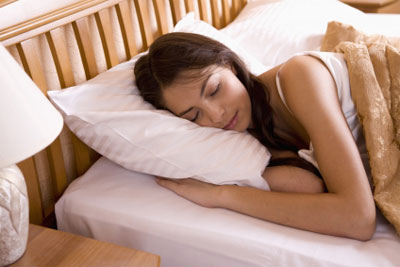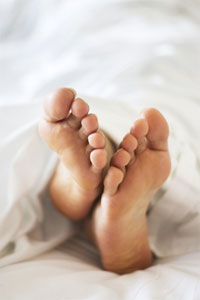General Guidelines
 There are very few requirements for the day leading up to your sleep study. However, it is very important to avoid caffeine (coffee, tea, cola, chocolate) after 12:00 NOON and not to nap. Before coming to the sleep center, eat a normal meal, wash and dry your hair, and do not apply hair sprays, oils or gels. Be sure to bring a change of clothes for the next day, toiletries and your favorite pillow.
There are very few requirements for the day leading up to your sleep study. However, it is very important to avoid caffeine (coffee, tea, cola, chocolate) after 12:00 NOON and not to nap. Before coming to the sleep center, eat a normal meal, wash and dry your hair, and do not apply hair sprays, oils or gels. Be sure to bring a change of clothes for the next day, toiletries and your favorite pillow.
Be sure to inform your physician about any medications that you may be taking well before your study night! This includes prescription medications, over the counter medications and dietary supplements such as melatonin and diet pills.
Arriving at the Sleep Center
The sleep technologist will greet you when you arrive at the sleep center and show you to your bedroom. At that time he/she will review the sleep study procedure with you and you will be given a chance to ask questions about any element of your study. The technologist will ask you fill out some forms and questionnaires. Be sure to let us know about your current health and physical condition. It is important to provide us the following information:
- Any medications you have taken in the 24 hours prior to your arrival.
- Any sleep difficulties you that have not already been discussed with your physician
- Any recent changes in you overall health. Do you have a cold or did you have trouble sleeping on the previous night?
- Do you need to be at work at a certain time the next day? You may want to reschedule other commitments for the morning, but if that is not possible confirm a wake-up time when you arrive at the sleep center.
After filling out your forms you’ll have time to make yourself comfortable, change into nightclothes and prepare for bed, just as you would at home. If there is additional time you can read, watch TV or relax as you normally would at home. Smoking or drinking alcohol is not permitted.
The Hook-up
Before bedtime, the technologist will attach the monitoring devices (electrodes, belts, sensors) that will allow us to assess your sleep patterns. All these devices are attached to the skin. They are quite small and designed to be as comfortable as possible.
Brainwave patterns and eye movements allow us to determine whether you are asleep or awake and help us determine each stage of sleep. Each night when you sleep you move through several levels of sleep called stages. When you dream, you are in a particular stage called REM sleep (which stands for Rapid Eye Movement sleep). This is an important stage in sleep medicine because breathing control diminishes in REM sleep and people suffering from Sleep Apnea tend to have their longest apneas and deepest oxygen desaturations when they are in REM sleep.
Breathing patterns allow us to determine when you are breathing and when you may be fighting for breath. When a person has an apnea they continue to try to breathe but their airway is blocked. We monitor both your breathing efforts and the amount of air flowing out of your nose and mouth. This allows us to determine when you are breathing and how long you stop breathing if you have an apnea.
Electrocardiogram and heart rate are measured to see how hard your heart is working during sleep. During an apnea the heart will slow down when you stop breathing and speed up as you struggle to breathe again.
Leg movements and muscle activity over the chin are measured to determine if you suffer from sleep related movement disorders such as periodic limb movements in sleep (leg kicking) or bruxism (teeth grinding). The chin muscles help us look for REM sleep because the body relaxes all your muscles while you are in that stage.
Oxygen levels are monitored by a device that looks like a small bandage. It determines the oxygen content of your blood by shining an infrared light through your finger or ear lobe. It is completely painless and is one of the most important aspects of the sleep study.
Breathing effort is measured with two belts strapped around your chest and abdomen (belly).
These electrodes and devices may feel strange at first on your skin, but most people do not find that they are
uncomfortable or prevent them from falling asleep. We recognize that your sleep in the center may not be
exactly like your sleep at home but this rarely interferes with the quality of the study.

